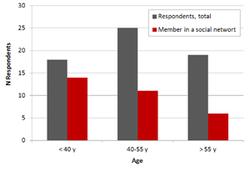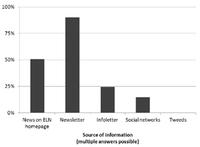Results of the survey "Social networks"
Since the annual symposium of the European LeukemiaNet earlier this year members of the ELN were asked to comment on their usage of social networks. The purpose of the survey was to find out whether the online presence of the ELN in a social network would be seen helpful for keeping the members up to date regarding new ELN website contents and features.
Fig. 1: Age distribution. Overall age distribution of responders (grey bars) compared to age distribution of responders who are members of a social network (red bars).
Until the end of May, over 60 physicians, scientists, and study coordinators from all over Europe completed the questionnaire. The age distribution of respondents is shown in fig. 1. Among the participants younger than 40 years 78 % are member of a social network. In the group aged 40 to 55 years this value drops to 44 % and decreases even more (32 %) among the respondents being older than 55 years.
With the exception of one respondent all participants want to keep up with the latest changes of the website content. Despite the large proportion of social network members only 15 % of all responders and less than 30 % of responders who are member of a social network would like to receive news on the ELN via this source (fig. 2).

Fig. 2: Preference for social networks as main source for information. A. Overall preference for social networks as main source for information. B. Preference for social networks among respondents who are member of a social network. (dark red: no preference; light red: social networks are prefered source of information).
In contrast, over 90 % stated that they would prefer to be informed by the newsletter which is distributed every second month. Another 50 % of the responders use the news section on the ELN homepage as main source (see fig. 3 for details).
Fig. 3: Prefered source of information. Percentage of responders prefering a distinct type of source. Multiple answers were possible.
Though Facebook (40 %), Linkedin (18 %), or Xing (13 %) are used by half of the ELN members who took part in this survey social networks do not seem to have a high priority as possible source for information on the European LeukemiaNet. As mainly younger ELN participants are member of social networks the importance of Facebook and others might increase in future. For now, ELIC will stick to the known sources to inform the ELN members.

